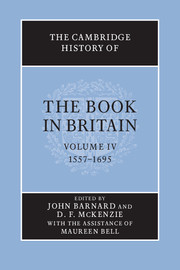Book contents
- Frontmatter
- Dedication
- Contents
- List of illustrations
- List of contributors
- Preface
- Acknowledgements
- Introduction
- RELIGION AND POLITICS
- ORAL TRADITIONS AND SCRIBAL CULTURE
- LITERATURE OF THE LEARNED
- 6 The Latin trade
- 7 Patronage and the printing of learned works for the author
- 8 University printing at Oxford and Cambridge
- 9 Editing the past: classical and historical scholarship
- 10 Maps and Atlases
- 11 The literature of travel
- 12 Science and the book
- 13 Samuel Hartlib and the commonwealth of learning
- 14 Ownership: private and public libraries
- 15 Monastic collections and their dispersal
- LITERARY CANONS
- VERNACULAR TRADITIONS
- THE BUSINESS OF PRINT AND THE SPACE OF READING
- BEYOND LONDON: PRODUCTION, DISTRIBUTION, RECEPTION
- DISRUPTION AND RESTRUCTURING: THE LATE SEVENTEENTH-CENTURY BOOK TRADE
- STATISTICAL APPENDICES
- Abbreviations
- Bibliography
- Index
- Plate Section
- References
8 - University printing at Oxford and Cambridge
from LITERATURE OF THE LEARNED
- Frontmatter
- Dedication
- Contents
- List of illustrations
- List of contributors
- Preface
- Acknowledgements
- Introduction
- RELIGION AND POLITICS
- ORAL TRADITIONS AND SCRIBAL CULTURE
- LITERATURE OF THE LEARNED
- 6 The Latin trade
- 7 Patronage and the printing of learned works for the author
- 8 University printing at Oxford and Cambridge
- 9 Editing the past: classical and historical scholarship
- 10 Maps and Atlases
- 11 The literature of travel
- 12 Science and the book
- 13 Samuel Hartlib and the commonwealth of learning
- 14 Ownership: private and public libraries
- 15 Monastic collections and their dispersal
- LITERARY CANONS
- VERNACULAR TRADITIONS
- THE BUSINESS OF PRINT AND THE SPACE OF READING
- BEYOND LONDON: PRODUCTION, DISTRIBUTION, RECEPTION
- DISRUPTION AND RESTRUCTURING: THE LATE SEVENTEENTH-CENTURY BOOK TRADE
- STATISTICAL APPENDICES
- Abbreviations
- Bibliography
- Index
- Plate Section
- References
Summary
The presses at Cambridge and Oxford in the sixteenth and seventeenth centuries were distinctive. Geographically and commercially they were isolated. Their printers were unlike printers in London in that they could have no everyday dealings with other presses nearby, since there were none. They were privileged. The government of these presses, and of the men who worked them, was unlike that of any press in London. They were protected by university interests. They were all these before they were in any sense learned.
Each town is about fifty miles from London, and though the Thames could be exploited by those wishing to move bulky and heavy quantities of paper between London and Oxford, distance remained an obstacle. For Cambridge, there was no such river, only roads that became muddy and difficult in winter. In some respects, Oxford looked also to the west and to the north and south, at a crossing of the river and on a main route to the Cotswold towns and to Wales. Cambridge was on no such obvious route, and even in the nineteenth century visitors to Britain tended to choose Oxford before Cambridge in planning their tours.
Universities expect textual authority; they require established prices for their books; they expect to exert control. In other words, they require an economic and reliable means of producing texts for teaching and for the promotion of scholarship. These requirements are common to the manufacture of printed books in universities in Britain in the sixteenth and seventeenth centuries and to manuscript books in the University of Bologna three hundred years earlier.
- Type
- Chapter
- Information
- The Cambridge History of the Book in Britain , pp. 189 - 205Publisher: Cambridge University PressPrint publication year: 2002
References
- 1
- Cited by



